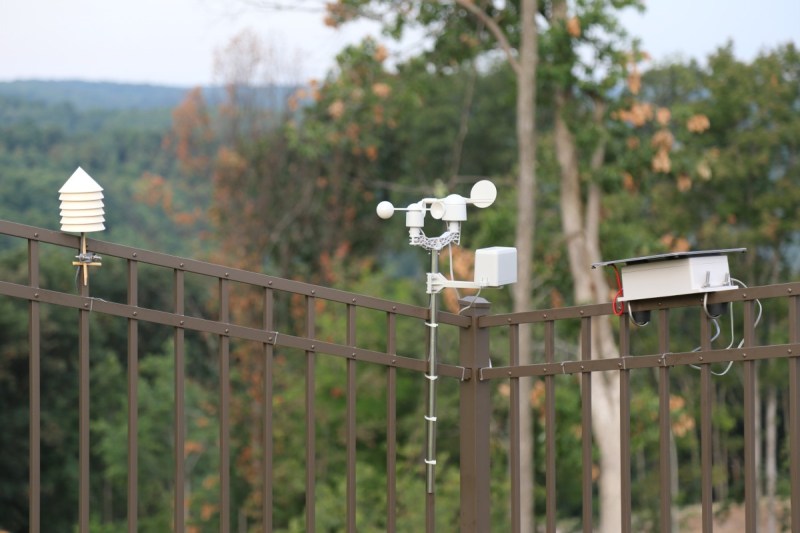There was a time when getting weather conditions was only as timely or as local as the six o’clock news from the nearest big-city TV station. Monitoring the weather now is much more granular thanks to the proliferation of personal weather stations. For the ultimate in personalized weather, though, you might want to build your own solar powered weather station.
It looks like [Brian Masney] went all out in designing his weather station. It supports a full stack of sensors – wind speed and direction, rain, temperature, pressure, and dew point. About the only other parameters not supported (yet) are solar radiation, UV, and soil moisture and temperature. The design looks friendly enough that adding those sensors should be a snap – if fact, the 3D models in his GitHub repo suggest that he’s already working on soil sensors. The wind and rain sensor boom is an off-the-shelf unit from Sparkfun, and the temperature and pressure sensors are housed in a very professional 3D printed screen enclosure. All the sensors talk to a Raspberry Pi living in a (hopefully) waterproof enclosure topped with a solar panel for charging the stations batteries. All in all it’s a comprehensive build; you can check out the conditions at [Brian]’s place on Weather Underground.
Weather stations are popular around these parts, as witnessed by this reverse-engineered sensor suite or even this squirrel-logic based station.
















There was a time when getting weather conditions was only as timely or as local as sticking one’s head out the door and observing it. Monitoring the weather now is much more quantitative…
How about hanging a Weather Rock outside, and point a webcam to it.
IOT connected weather rock!
YES!!
Weather Stick tells the weather too.
A bunch of the datasheet links in his README are broken, and I’ve been looking for a good anemometer but this readme doesn’t talk at all about how his was built (I guess the ADC + reed switch in a 3d printed enclosure?), also I’ve got no idea how his rain gauge works. More information please! :D
I’ve got the same sensor cluster
The rain gauge and anemometer are these
https://www.sparkfun.com/products/8942
There is a datasheet there.
The rain gauge and anemometer is a tipping bucket arrangement with a reed switch which seems to be very accurate.
The Wind direction is done thru a resistor ladder hooked up to an ADC.
Overall works well
Hey!
The hardware is of the rack. The aneometer and winddirection sensors work with reed switches. The winddirection sensor comes with eight switches, 4 of them (every 90 degree) have a larger sensind area than the other 4 (every 90 + 45 degree). The rainsensor works like a seesaw, Once there is enough water, it will swing down, produce a pulse, release the water and go up again.
User lakid posted a source for the hardware.
Thanks for the info PW and lakid! That bundle looks perfect!
I love weather stations, and it’s nice to see someone put something like this together. However, I think component choice is not very good. First of all, do you really need RPi with USB WiFi stick for this task? Wouldn’t some ATMega or PIC18F in combination with ESP8266 be much simpler and less power-hungry choice? Maybe even just ESP8266? With 35 hours battery capacity it could be a problem if there are few dark and/or stormy days in a row. Also, DHT22 is not very good sensor for weather stations, something like BME280 is much better choice.
I use an Arduino Pro mini with a BME280, VEM6070, TSL2561 and the Sparkfun weather meters here
https://www.sparkfun.com/products/8942.There is a data sheet there too.
The design is based on the Sparkfun weather shield with a bunch of other sensors (all I2C for power consumption).
Mine uses interrupts on the anemometer so when it’s not windy the whole thing goes into deep sleep with the Rocketscream lib. It uses an nrf24l01+ as the radio and the solar charges the battery via a Sparkfun Sunny Buddy.
As a base station I use a RPI, hooked up to an nrf24l01+
Snapshot of the output data is here (via influxdb, grafana and raintank.io)
https://snapshot.raintank.io/dashboard/snapshot/cfF94RyvwD76T3WVLJS2C5qLmFGqdKff
I have on my side designed a wireless autonomous weather station based on ESP8266: http://chynehome.com/web/station-meteo-a-base-de-esp8266-2/
the code is not very clean but works. I have a version 3 under test with a sensor sensiron for temperature and humidity.
With a small solar panel and a battery LIPO 4.2V 6A not need to sleep the esp8266.
I hope the batteries stay charged, a raspberry pi isn’t a terribly efficient ARM board. From what I remember idle power consumption is a watt and full load is about 3.5 to 4W. That could probably be brought down to half a watt with the right settings, putting far less strain on the battery which could be useful during the winter months.
This is an interesting project, build a complete weather station suite using Raspberry Pi with acceptable price. It is perfect for who like DIY weather station.
But compare to other complete weather station, I think it is missing some useful feature like console, alarm, graph, prediction weather, auto calibrate sensor …
Or I read missing about it in GitHub page.
I am doing the similar project but I am a beginner on the raspberry pi can you please supply the code you used I am stuck